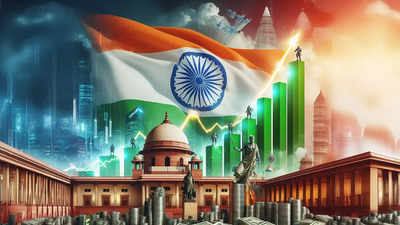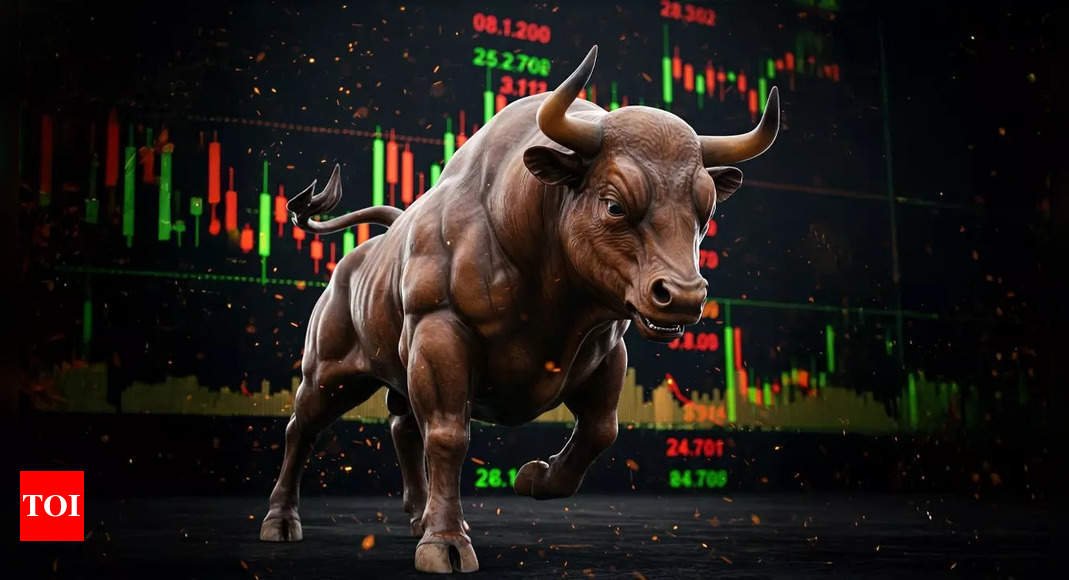India’s Gross Domestic Product (GDP) has doubled in the last 10 years – a huge feat for an economy that is also set to become the world’s third largest in a few years. India’s economic growth has come despite a major economic setback in the form of the Covid pandemic a few years ago.
According to latest International Monetary Fund (IMF) data, India’s GDP under the Narendra Modi government has seen 103.1% growth in GDP at current prices or nominal GDP. It has also gone from being the world’s 10th largest economy to the fifth largest.
How has India managed to double its GDP in just ten years? What factors have worked to propel the economy, which at one time had been infamously ranked among the ‘Fragile Five’? As India looks set to become the world’s fourth largest economy next year, and the third largest in the later part of this decade, we take a look at 7 charts that show the incredible growth story of India and ask experts about what led to the 100% rise in GDP:
India’s Rise in numbers
- India’s nominal GDP in 2015 was $2,103.6 billion. Come 2025, the IMF projects that it will reach $4,271.9 billion. That’s over 100% growth in just 10 years!
- Among the top 10 largest world economies, India has exhibited the highest growth in GDP. Three out of the present top 4 world economies have seen a decent GDP growth in 10 years; 65.8% for the US, 75.8% for China and 43.7% for Germany. Japan’s economy has contracted 1.3% in the last 10 years, as per IMF’s October 2024 World Economic Outlook.
- Back in 2014, India was the world’s 10th largest economy in terms of nominal GDP. From there, it has risen through the ranks to become the world’s 5th largest economy – a feat it achieved in 2021.
- A recent SBI Research report notes that with the government’s efforts to ensure quality of life for all citizens and stopped leakage of benefits through Direct Benefit Transfer, the per capita GDP at current prices stood at Rs 2.35 lakh in FY25, with decadal CAGR growth of 9.1%. “In constant prices too, per capita GDP has increased to Rs 1.33 lakh in FY25. In the last two fiscals, the per capita GDP jumped by more than Rs 40,000 at current prices,” says the SBI Research report.
When will India become the world’s 3rd largest economy?
Suggesting strong economic fundamentals, India will continue to be the fastest growing major economy in the coming years as well, says IMF. It has projected that India’s GDP will grow at 6.5% in both FY 2025 and FY 2026.
All other top 10 world economies will grow at much lower rates – with China projected to see the second highest GDP growth rate of 4.5%.
With a healthy GDP growth rate, the Indian economy is expected to surpass Japan in 2026 as the world’s 4th largest economy. It is likely to become the third largest economy in the world in nominal GDP terms by 2028, according to IMF projections.
India’s GDP is expected to rise to $5723.3 billion by 2028 and $6307.2 billion by 2029. In 2029, the world’s largest economy, the US, is projected to have a GDP of $35458 billion – which is 5.62 times India’s GDP!
In the interactive chart above, we take a look at India’s rise from 2015 to 2029 (projected). The GDP data for US and China is not highlighted since they will continue to the top two world economies through these years.
What’s led to the doubling of India’s GDP?
Economists credit the government policies and reforms with focus on manufacturing sector, exports, digitalization, GST and capital expenditure push for the infrastructure sector as major reasons for the astounding rise in nominal GDP numbers.
Madan Sabnavis, chief economist at Bank of Baroda says a number of factors have come together to enable this rather remarkable growth in the Indian economy:
1. Agriculture has been very resilient in this decade notwithstanding erratic climatic conditions. This is something which has kept output ticking as well as rural incomes stable.
2. India Inc has delivered quite well over the years in terms of expansion of business, investment, employment and diversification. This has created a very strong industrial sector. Several industries are a part of global supply chains.
3. The government has provided a very facilitative framework for business through a plethora of policies like Make in India, PLI, tax regime, MSME loans etc, he tells TOI.
a. At the same time the upliftment for the lower segments through direct measures has elevated standard of living as comes out from the consumption survey data.
b. The widespread use of technology though the digitization process has cut down on cost and ensured transparency in dealings.
c. GST has been a major breakthrough which has improved transparency.
d. The fiscal deficit has been brought under control with the focus being on prudence which has allowed the government to spend more on capex.
Also Read | Trump tariffs impact: Is a US recession likely and does India need to worry about it?
4. The services sector has been a major driver of the economy.
a. The service export component has been a major driver of growth.
b. The logistics and retail segments have seen exponential growth with demand being robust.
5. The RBI has brought about a sea change in different areas.
a. Made the banking system resilient and robust by leaning up balance sheets of banks.
b. Brought in pro-active regulation to ensure stability of the system.
c. Monetary policy streamlined on global standards with MPC to fight inflation.
6. The large flow of FDI has supplemented domestic capital and enhanced investment in the country.
7. The capital market has enabled raising of both equity and debt which is required for financing investment in the country. Here the regulator SEBI has been proactive all through to ensure there are no mis-steps.
“Therefore, the story is one of pragmatic polices, prudent regulation, successful business entrepreneurship which has moulded well in the process of globalization,” he tells TOI.
Also Read | Why Jim Walker, man who foresaw 2008 market crash, wants investors to ‘absolutely double down’ on Indian equities
According to Dharmakirti Joshi, Chief Economist at CRISIL, “The government’s emphasis on infrastructure development has contributed to higher-than-expected GDP growth following the pandemic. The introduction of GST enhanced tax compliance and increased government revenues, enabling greater budgetary spending on infrastructure.”
DK Joshi also believes that the rapid advancements in digital infrastructure have facilitated efficient payment systems, quicker credit delivery, and fostered innovation. “The healthy balance sheets of banks have also supported faster credit growth,” he tells TOI.
Radhika Rao, Senior Economist at DBS Bank notes that in the past decade, there has been a strong focus towards higher capital expenditure from the government as well as households, with the latter reflected in rising contribution to real estate and construction.
She credits the successive budgets that have seen a sharp increase in capex outlays, which has positive multipliers for the economy while the stickier revenue expenditure has been gradually rationalised.
“Concurrently, the composition of external trade has also undergone a change with rising share of manufactured goods in exports and strong gains in services, led by the contribution of global capability centres. These have not only helped make the net export balance less negative but have also helped to improve the health of the current account balance,” she tells TOI.
Also Read | Donald Trump’s tariffs: India may be among least vulnerable Asian economies in trade war with US – but there’s a catch!
India’s real GDP growth rate was 9.2% for 2023-24 – which is the highest in the previous 12 years except FY22 growth (9.7%, which is highest since independence). The economy has recovered well from the GDP growth slowdown of Q2 FY2025, with a 6.2% growth in the third quarter.
India looks set to rank among the top three economies in the coming years. But in a world of increasing economic uncertainties, and the threat of US tariffs looming, it will have to proactively manage its fiscal and monetary policies to stay on the high growth path.




